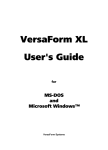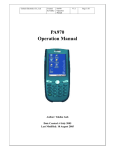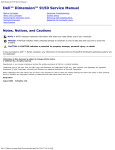Download VTA-7570T 5.7” QVGA Windows0R CE-based SCADA
Transcript
VTA-7570T 5.7” QVGA Windows○R CE-based SCADA HMI User’s Manual Disclaimers The information in this manual has been carefully checked and is believed to be accurate. AXIOMTEK Co., Ltd. assumes no responsibility for any infringements of patents or other rights of third parties, which may result from its use. AXIOMTEK assumes no responsibility for any inaccuracies that may be contained in this document. AXIOMTEK makes no commitment to update or to keep current the information contained in this manual. AXIOMTEK reserves the right to make improvements to this document and/or product at any time and without notice. No part of this document may be reproduced, stored in a retrieval system, or transmitted, in any form or by any means, electronic, mechanical, photocopying, recording, or otherwise, without the prior written permission of AXIOMTEK Co., Ltd. Copyright 2009 by AXIOMTEK Co., Ltd. All rights reserved. January 2009, Version A1 Printed in Taiwan ii Safety Approvals u CE Marking u FCC Class A FCC Compliance This equipment has been tested and complies with the limits for a Class A digital device, pursuant to Part 15 of the FCC Rules. These limits are designed to provide reasonable protection against harmful interference in a residential installation. If not installed and used in accordance with proper instructions, this equipment might generate or radiate radio frequency energy and cause harmful interference to radio communications. However, there is no guarantee that interference will not occur in a particular installation. If this equipment does cause harmful interference to radio or television reception, which can be determined by turning the equipment off and on, the user is encouraged to try to correct the interference by one or more of the following measurers: 1. 2. 3. 4. Reorient or relocate the receiving antenna. Increase the separation between the equipment and receiver. Connect the equipment into an outlet on a circuit different from that to which the receiver is connected. Consult the dealer or an experienced radio/TV technician for help. Shielded interface cables must be used in order to comply with emission limits. iii Safety Precautions Before getting started, read the following important cautions. 1. The VTA-7570T does not come equipped with an operating system. An operating system must be loaded first before installing any software into the computer. 2. Be sure to ground yourself to prevent static charge when installing the internal components. Use a grounding wrist strap and place all electronic components in any static-shielded devices. Most electronic components are sensitive to static electrical charge. 3. Disconnect the power cord from the VTA-7570T before making any installation. Be sure both the system and the external devices are turned OFF. Sudden surge of power could ruin sensitive components. Make sure the VTA-7570T is properly grounded. 4. The brightness of the flat panel display decreases with usage. However, hours of use vary depending on the application environment. 5. Turn OFF the system power before cleaning. Clean the system using a cloth only. Do not spray any liquid cleaner directly onto the screen. The VTA-7570T comes with a touch screen. Although the touch screen is chemical resistant, it is recommended that you spray the liquid cleaner on a cloth first before wiping the screen. In case your system comes without the touch screen, you must follow the same procedure and not spray any cleaner on the flat panel directly. 6. Avoid using sharp objects to operate the touch screen. Scratches on the touch screen may cause malfunction or internal failure to the touch screen. 7. The flat panel display is not susceptible to shock or vibration. When assembling the VTA-7570T, make sure it is securely installed. iv 1. Do not open the system’s back cover. If opening the cover for maintenance is a must, only a trained technician is allowed to do so. Integrated circuits on computer boards are sensitive to static electricity. To avoid damaging chips from electrostatic discharge, observe the following precautions: ü Before handling a board or integrated circuit, touch an unpainted portion of the system unit chassis for a few seconds. This will help to discharge any static electricity on your body. ü When handling boards and wrist-grounding strap, available component stores. components, from most wear a electronic Trademarks Acknowledgments AXIOMTEK is a trademark of AXIOMTEK Co., Ltd. IBM, PC/AT, PS/2, VGA are trademarks of International Business Machines Corporation. Intel and Pentium are trademarks of Intel Corporation. MS-DOS, Microsoft C and Quick BASIC are trademarks of Microsoft Corporation. VIA is a trademark of VIA Technologies, Inc. SST is a trademark of Silicon Storage Technology, Inc. UMC is a trademark of United Microelectronics Corporation. Other brand names and trademarks are the properties of their respective owners. v This page does not contain any information. vi Table of Contents Disclaimers .......................................................................ii Safety Approvals..............................................................iii FCC Compliance..............................................................iii Safety Precautions ...........................................................iv CHAPTER 1 INTRODUCTION ............................................. 1 1.1 General Description ............................................ 1 1.2 Specifications...................................................... 2 1.2.1 Main CPU board............................................... 2 1.2.2 I/O System ....................................................... 2 1.2.3 System Specification........................................ 3 1.2.4 Software Specification...................................... 3 1.3 Dimensions ......................................................... 3 1.4 I/O Outlets........................................................... 5 1.5 Package list ........................................................ 6 CHAPTER 2 HARDWARE INSTALLATION.......................... 7 2.1 CompactFlash Card Installation .......................... 7 2.2 PC/104 Installation.............................................. 8 2.3 Serial Port Interface ............................................ 9 2.4 Ethernet ............................................................ 10 2.5 Mounting Way : Panel mount ............................ 11 CHAPTER 3 PHOENIX-AWARD BIOS UTILITY................. 12 3.1 Entering Setup .................................................. 12 3.2 Control Keys ..................................................... 13 3.3 Getting Help...................................................... 13 3.4 The Main Menu ................................................. 14 3.5 Standard CMOS Setup Menu............................ 15 3.6 Advanced BIOS Features ................................. 18 3.7 Advanced Chipset Features .............................. 21 3.8 Integrated Peripherals....................................... 23 3.9 Power Management Setup................................ 28 3.10 PnP/PCI Configuration Setup............................ 30 3.11 PC Health Status .............................................. 32 Table of Contents vii 3.12 3.13 3.14 3.15 Load Optimized Defaults................................... 33 Set Supervisor/User Password ......................... 34 Save & Exit Setup ............................................. 35 Exit Without Saving........................................... 36 CHAPTER 4 HMI RUNTIME USER GUIDE........................ 38 viii Table of Contents VTA-7570T User’s Manual CHAPTER 1 INTRODUCTION This chapter contains the general information and the detail specifications of the VTA-7570T. Chapter 1 includes the following sections: n n n n n 1.1 General Description System Specification Dimensions I/O Outlets Package List General Description The VTA-7570T is a 5.7” fanless TFT QVGA touch panel computer. It is equipped with CISI-based low power consumption processor, AMD LX800. By supporting the option of external battery set, the VTA-7570T can continue system operation if a main power shortage ever happens. In addition, the PC/104 and Mini-PCI slots are reserved for expansion availability. The VTA-7570T supports CompactFlash card and is the best choice for applications of factory automation, machinery maker, building automation and semi-conductor. Introduction 1 VTA-7570T User’s Manual 1.2 1.2.1 Specifications Main CPU board n CPU: AMD LX800 500MHz n System Chipset: AMD LX + CS5536AD n BIOS: Phoenix-Award 4Mbit with RPL/PXE Ethernet Boot ROM, Smartview and customer CMOS backup. n System Memory: One 184-pin DDR DIMM Maximum up to 1GB 1.2.2 I/O System n Standard I/O: − 2 x serial ports (1 x RS-232, 1 x RS-232/422/485) − 2 x USB Ports 2.0 compliant n Ethernet: Equipped with 1 x RJ-45 for 10/100 base-T n Audio: Realtek AC’97 codec audio (Line-out) n Expansion: Equipped with 1 x Mini-PCI & 1 x PC/104 n Compact Flash Socket: One Compact Flash Type II Socket 2 Introduction VTA-7570T User’s Manual 1.2.3 n n n n System Specification 5.7” QVGA TFT LCD Disk drive housing: − 1 x Compact Flash Type II Socket DC 24V power supply Heat dispensing design n Net weight: − 2.0 Kgs n Dimension (main body size): − 208.5 x 167.3 x 66.5 mm n Operating temperature: − O° to 45°C ; Relative umidity:50% Relative humidity: − 10% to 85% @ 40° C, non-condensing n n Altitude: − 10,000 ft. (3,000 meters) n Vibration (operating): − 5 to 500 Hz, 1 G random Shock (operating): − 10 G peak acceleration (11 msec. duration) n 1.2.4 n Software Specification Operating System − Windows CE.NET 6.0 n HMI Software − WinPC32 Pro 1.3 Dimensions The following diagrams show the dimensions and outlines of VTA-7570T. Introduction 3 VTA-7570T User’s Manual 4 Introduction VTA-7570T User’s Manual 1.4 I/O Outlets The following figure shows the I/O locations of the VTA-7570T. 1: Power Switch 6: LAN 2: DC power connector 7: USB 2.0 x 2 3: COM 2 (RS-232) 8: Line-out 4: COM 1 (RS-232/422/485) 9: CompactFlash card 5: PC/104 slot Introduction 5 VTA-7570T User’s Manual 1.5 Package list When you receive the VTA-7570T, there are following items in the package. If you can not find it, please contact AXIOMTEK distributors. 1. VTA-7570T x 1 2. Panel mount kit x 6 3. Driver CD x1 6 Introduction VTA-7570T User’s Manual CHAPTER 2 HARDWARE INSTALLATION The VTA-7570T provides rich I/O ports and flexible expansions for you to meet different demand such as PCMCIA, WLAN module and so on. The chapter will show you how to install the hardware. It includes: n CompactFlash Card n PC/104 n Serial Port n Ethernet n Mounting Way 2.1 CompactFlash Card Installation VTA-7570T offers one CF slot for users to install CompactFlash card. Hardware Installation 7 VTA-7570T User’s Manual Please refer to the following instructions and illustration: 1. Remove the rubber cover at left-side. 2. Install CompactFlash card in the VTA-7570T. 2.2 PC/104 Installation The VTA-7570T offers a convenient expansion for users to install PC/104 module such as PCMCIA, WLAN, COM port card and so on. 8 Hardware Installation VTA-7570T User’s Manual Please follow the steps: 1. Unscrew screws to remove the bracket. 2. Install PC/104 module. 2.3 Serial Port Interface The VTA-7570T has two onboard (RS-232/422/485) & COM2 (RS-232). Hardware Installation serial ports, COM1 9 VTA-7570T User’s Manual The pin assignments are listed below: Description 1 Data Carrier Detect (DCD) 2 Receive Data (RXD) 3 Transmit Data (TXD) 4 Data Terminal Ready (DTR) 5 Ground (GND) 6 Data Set Ready (DSR) 7 Request to Send (RTS) 8 Clear to Send (CTS) 9 Ring Indicator (RI) In addition, COM1 can be set for RS-232/422/485 by jumper. The jump setting is listed as below: COM1 JP12 JP10 JP11 RS-232 (default) 1-2 3-5, 4-6 3-5, 4-6 RS-422 3-4, 7-8 1-3, 2-4 1-3, 2-4 RS-485 5-6, 7-8 1-3, 2-4 1-3, 2-4 COM2 2.4 COM1 Ethernet The VTA-7570T provides an NE2000 compatible Ethernet (RJ-45) interface. For network connection, just plug in one cable end of the 10 Hardware Installation VTA-7570T User’s Manual VTA-7570T 10/100 Base-T Hub into the standard RJ-45 connector. The pin assignment of the RJ-45 is listed below; Signal Pin 2.5 1 TX+ (Data transmission positive 2 TX- (Data transmission negative) 3 Rx+(Data reception positive) 4 RJ45 termination 5 RJ45 termination 6 Rx- (Data reception negative) 7 RJ45 termination 8 RJ45 termination 1 2 3 4 5 6 7 8 RJ-45 Mounting Way : Panel mount The VTA-7570T is designed for panel mount application. To mount the VTA-7570T, the standard set of mounting kit (included in the system packaging) is needed. Hardware Installation 11 VTA-7570T User’s Manual CHAPTER 3 PHOENIX-AWARD BIOS UTILITY The Phoenix-Award BIOS provides users with a built-in Setup program to modify basic system configuration. All configured parameters are stored in a battery-backed-up RAM (CMOS RAM) to save the Setup information whenever the power is turned off. 3.1 Entering Setup There are two ways to enter the Setup program. You may either turn ON the computer and press <Del> immediately, or press the <Del> and/or <Ctrl>, <Alt>, and <Esc> keys simultaneously when the following message appears at the bottom of the screen during POST (Power on Self Test). TO ENTER SETUP PRESS DEL KEY If the message disappears before you respond and you still want to enter Setup, please restart the system to try it again. Turning the system power OFF and ON, pressing the “RESET” button on the system case or simultaneously pressing <Ctrl>, <Alt>, and <Del> keys can restart the system. If you do not press keys at the right time and the system doesn’t boot, an error message will pop out to prompt you the following information: PRESS <F1> TO CONTINUE, <CTRL-ALT-ESC> OR <DEL> TO ENTER SETUP 12 PHOENIX-AWARD BIOS UTILITY VTA-7570T User’s Manual 3.2 Control Keys Up arrow Move cursor to the previous item Down arrow Move cursor to the next item Left arrow Move cursor to the item on the left hand Right arrow Move to the item in the right hand Esc key PgUp/“+” key Main Menu -- Quit and delete changes into CMOS Status Page Setup Menu and Option Page Setup Menu -- Exit current page and return to Main Menu Increase the numeric value or make changes PgDn/“−“ key Decrease the numeric value or make changes F3 key General help, only for Status Page Setup Menu and Option Page Setup Menu Change color from total 16 colors. F2 to select color forward, (Shift) F2 to select color backward Reserved F4 key Reserved F1 key (Shift) F2 key F8 key Restore the previous CMOS value from CMOS, only for Option Page Setup Menu Load the default CMOS value from BIOS default table, only for Option Page Setup Menu Load the Setup default, only for Option Page Setup Menu Reserved F9 key Reserved F10 key Save all the CMOS changes, only for Main Menu F5 key F6 key F7 key 3.3 Getting Help l Main Menu The online description of the highlighted setup function is displayed at the bottom of the screen. l Status Page Setup Menu/Option Page Setup Menu Press <F1> to pop out a small Help window that provides the description of using appropriate keys and possible selections for highlighted items. Press <F1> or <Esc> to exit the Help Window. PHOENIX-AWARD BIOS UTILITY 13 VTA-7570T User’s Manual 3.4 The Main Menu Once you enter the Award BIOS CMOS Setup Utility, the Main Menu appears on the screen. In the Main Menu, there are several Setup functions and a couple of Exit options for your selection. Use arrow keys to select the Setup Page you intend to configure then press <Enter> to accept or enter its sub-menu. NOTE If your computer can not boot after making and saving system changes with Setup, the Award BIOS will reset your system to the CMOS default settings via its built-in override feature. It is strongly recommended that you should avoid changing the chipset’s defaults. Both Award and your system manufacturer have carefully set up these defaults that provide the best performance and reliability. 14 PHOENIX-AWARD BIOS UTILITY VTA-7570T User’s Manual 3.5 Standard CMOS Setup Menu The Standard CMOS Setup Menu displays basic information about your system. Use arrow keys to highlight each item, and use <PgUp> or <PgDn> key to select the value you want in each item. l Date The date format is <day>, <date> <month> <year>. Press <F3> to show the calendar. day It is determined by the BIOS and read only, from Sunday to Saturday. date It can be keyed with the numerical/ function key, from 1 to 31. month It is from January to December. year It shows the current year of BIOS. l Time This item shows current time of your system with the format <hour> <minute> <second>. The time is calculated based on the 24-hour military-time clock. For example, 1 p.m. is 13:00:00. PHOENIX-AWARD BIOS UTILITY 15 VTA-7570T User’s Manual l IDE Primary Master/Primary Slave These items identify the types of each IDE channel installed in the computer. There are 45 predefined types (Type 1 to Type 45) and 2 user’s definable types (Type User) for Enhanced IDE BIOS. Press <PgUp>/<+> or <PgDn>/<−> to select a numbered hard disk type, or directly type the number and press <Enter>. Please be noted your drive’s specifications must match the drive table. The hard disk will not work properly if you enter improper information. If your hard disk drive type does not match or is not listed, you can use Type User to manually define your own drive type. If selecting Type User, you will be asked to enter related information in the following items. Directly key in the information and press <Enter>. This information should be provided in the documentation from your hard disk vendor or the system manufacturer. If the HDD interface controller supports ESDI, select “Type 1”. If the HDD interface controller supports SCSI, select “None”. If the HDD interface controller supports CD-ROM, select “None”. CYLS. number of cylinders LANDZONE landing zone HEADS SECTORS number of heads number of sectors PRECOMP write precom MODE HDD access mode If there is no hard disk drive installed, select NONE and press <Enter>. l Video Select the display adapter type for your system. 16 PHOENIX-AWARD BIOS UTILITY VTA-7570T User’s Manual l Halt On This item determines whether the system will halt or not, if an error is detected while powering up. No errors The system booting will halt on any errors detected. (default) All errors Whenever BIOS detects a non-fatal error, the system will stop and you will be prompted. All, But Keyboard The system booting will not stop for a keyboard error; it will stop for other errors. All, But Diskette The system booting will not stop for a disk error; it will stop for other errors. All, But Disk/Key The system booting will not stop for a keyboard or disk error; it will stop for other errors. Press <Esc> to return to the Main Menu page. PHOENIX-AWARD BIOS UTILITY 17 VTA-7570T User’s Manual 3.6 Advanced BIOS Features This section allows you to configure and improve your system, to set up some system features according to your preference. l First/Second/Third Boot Device st nd rd These items let you select the 1 , 2 , and 3 devices that the system will search for during its boot-up sequence. The wide range of selection includes Floppy, LS120, ZIP100, HDD0~3, SCSI, and CDROM. l Boot Other Device This item allows users to enable or disable the boot device not listed in the First/Second/Third boot devices option above. The default setting is “Enabled”. l Boot Up NumLock Status Set the the Num Lock status when the system is powered on. The default value is “On”. 18 PHOENIX-AWARD BIOS UTILITY VTA-7570T User’s Manual l Gate A20 Option The default value is “Fast”. Normal The A20 signal is controlled by keyboard controller or chipset hardware. Fast Default: Fast. The A20 signal is controlled by Port 92 or chipset specific method. l Typematic Rate Setting This item determines the typematic rate of the keyboard. The default value is “Disabled”. Enabled Disabled Enable typematic rate and typematic delay programming. Disable typematic rate and typematic delay programming. The system BIOS will use default value of these 2 items, controlled by keyboard. l Typematic Rate (Chars/Sec) This option refers to character numbers typed per second by the keyboard. The default value is “6”. 6 6 characters per second 8 8 characters per second 10 10 characters per second 12 12 characters per second 15 15 characters per second 20 20 characters per second 24 24 characters per second 30 30 characters per second l Typematic Delay (Msec) This option defines how many milliseconds must elapse before a held-down key begins generating repeat characters. The default value is “250”. 250 250 msec 500 500 msec 750 750 msec 1000 1000 msec PHOENIX-AWARD BIOS UTILITY 19 VTA-7570T User’s Manual l Security Option This item allows you to limit access to the system and Setup, or just to Setup. The default value is “Setup”. System If a wrong password is entered at the prompt, the system will not boot, the access to Setup will be denied, either. Setup If a wrong password is entered at the prompt, the system will boot, but the access to Setup will be denied. NOTE To disable the security, select PASSWORD SETTING at Main Menu and then you will be asked to enter a password. Do not type anything, just press <Enter> and it will disable the security. Once the security is disabled, the system will boot and you can enter Setup freely. l Small Logo(EPA) Show If enabled, the EPA logo will appear during system booting up; if disabled, the EPA logo will not appear. Press <Esc> to return to the Main Menu page. 20 PHOENIX-AWARD BIOS UTILITY VTA-7570T User’s Manual 3.7 Advanced Chipset Features This section contains completely optimized chipset’s features on the board that you are strongly recommended to leave all items on this page at their default values unless you are very familiar with the technical specifications of your system hardware. l CPU Frequency Use this item to set the CPU Frequency with these options: Auto, 333MHz, 400MHz, 433MHz and 500MHz. The default setting is “Auto”. l Memory Frequency This item helps you set main memory frequency. When using an external graphics card, it can be adjusted to enable the best performance for your system. l CAS Latency Time You can select CAS latency time to HCLKs 2, 3, or Auto. The board designer should have set up these values in accordance with the installed DRAM. Do not change these values unless you PHOENIX-AWARD BIOS UTILITY 21 VTA-7570T User’s Manual have to change the specifications of the installed DRAM or CPU. l Video Memory Size The available options are “8M”, “16M”, “32M”, “64M”, “128M” and “254M”. l Output Display This item allows you to choose the output for your system display. Configuration options are “CRT”, “Flat Panel” and “Panel & CRT”. The default value is “Panel & CRT”. l Flat Panel Configuration Scroll to this item and press <Enter> to view the Flat Panel Configuration sub menu. Ø Ø Resolution Select the resolution for LVDS panel. Data Bus Type Select the Data Bus Type for LVDS panel. Ø Ø 22 Refresh Rate Select the refresh rate for LVDS panel. HSYNC Polarity The available options are “HI” and “LOW”. PHOENIX-AWARD BIOS UTILITY VTA-7570T User’s Manual Ø Ø Ø VSYNC Polarity Active The available options are “HI” and “LOW”. SHFCLK Active Period Select the shift clock (SHFCLK) to be either free running, or active only during the display period. Some TFT panels recommend keeping the shift clock running during the retrace time. LP Active Period Select the polarity of the LDE/MOD pin. This can be used for panels that require an active low timing LDE interface signal. Press <Esc> twice to return to the Main Menu page. 3.8 Integrated Peripherals This section allows you to configure your SuperIO Device, IDE Function and Onboard Device. PHOENIX-AWARD BIOS UTILITY 23 VTA-7570T User’s Manual l Super IO Device Scroll to this item and press <Enter> to view the sub menu Super IO Device. Ø Onboard Serial Port 1/2/3 Select an address and corresponding interrupt for the serial port. Options: 3F8/IRQ4, 2F8/IRQ3, 3E8/IRQ10, 2E8/IRQ11, 338/IRQ5, 238/IRQ7, Auto and Disabled. Press <Esc> to return to the Integrated Peripherals page. 24 PHOENIX-AWARD BIOS UTILITY VTA-7570T User’s Manual l IDE Function Setup Scroll to this item and press <Enter> to view the sub menu IDE Function Setup. Ø Ø Ø Ø Master/Slave Drive PIO Mode The four IDE PIO (Programmed Input/Output) fields let you set a PIO mode (0-4) for each of the four IDE devices that the onboard IDE interface supports. Modes 0 to 4 provide successively increased performance. In Auto mode, the system automatically determines the best mode for each device. IDE Primary/Secondary Master/Slave UDMA Select the mode of operation for the IDE drive. Ultra DMA-33/66/100/133 implementation is possible only if your IDE hard drive supports it and the operating environment includes a DMA driver. If your hard drive and system software both support Ultra DMA-33/66/100/133, select Auto to enable UDMA mode by BIOS. IDE DMA transfer access Automatic data transfer between system memory and IDE device with minimum CPU intervention. This improves data throughput and frees CPU to perform other tasks. IDE HDD Block Mode Block mode is also called block transfer, multiple commands, or multiple sector read/write. If your IDE hard drive supports block mode (most new drives do), select Enabled for automatic detection of the optimal number of PHOENIX-AWARD BIOS UTILITY 25 VTA-7570T User’s Manual block read/writes per sector the drive can support. Press <Esc> to return to the Integrated Peripherals page. l Onboard Device Scroll to this item and press <Enter> to view the sub menu Onboard Device. Ø Ø Ø Ø Onboard Audio Use this item to enable or disable the onboard Audio function. Onboard USB1.1 Enable this item if you are using the EHCI (USB1.1) controller in the system. Onboard USB 2.0 Enable this item if you are using the EHCI (USB2.0) controller in the system. Onboard Lan Boot ROM Use this item to enable or disable the Boot ROM function of the onboard LAN chip when the system boots up. Press <Esc> to return to the Integrated Peripherals page. 26 PHOENIX-AWARD BIOS UTILITY VTA-7570T User’s Manual l ITE8888 Configure Scroll to this item and press <Enter> to view the sub menu ITE8888 Configure. Press <Esc> twice to return to the Main Menu page. PHOENIX-AWARD BIOS UTILITY 27 VTA-7570T User’s Manual 3.9 Power Management Setup The Power Management Setup allows you to save energy of your system effectively. It will shut down the hard disk and turn OFF video display after a period of inactivity. l ACPI Function This item allows you to enable/disable the Advanced Configuration and Power Management (ACPI). The function is always “Enabled”. l Power Management This option allows you to select the type of power Management. Options are: “APM”, “ACPI”. ** PM Timers ** l Standby Mode After the selected period of system inactivity, the fixed disk drive and the video shut off while all other devices still operate at full speed. 28 PHOENIX-AWARD BIOS UTILITY VTA-7570T User’s Manual l Suspend Mode After a selected period of system inactivity (1 minute to 1 hour), all devices except the CPU shut off. The default value is “Disabled”. Disabled 1/2/4/6/8/10/2 0/30/40 Min/1 Hr The System will never enter the SUSPEND mode. It defines continuous idle time before the system entering the SUSPEND mode. If any item defined in (J) is enabled and active, the SUSPEND timer will be reloaded. l HDD Power Down If HDD activity is not detected for a specified length of time in this field, the hard disk drive will be powered down while other devices remain active. l Moden Use IRQ If you want an incoming call on a modem to automatically resume the system from a powersaving mode, use this item to specify the interrupt request line (IRQ) used by the modem. You might have to connect the fax/modem to the board Wake On Modem connector for working this feature. Press <Esc> to return to the Main Menu page. PHOENIX-AWARD BIOS UTILITY 29 VTA-7570T User’s Manual 3.10 PnP/PCI Configuration Setup This section describes the configuration of PCI (Personal Computer Interconnect) bus system, which allows I/O devices to operate at speeds close to the CPU speed while communicating with other important components. This section covers very technical items that only experienced users could change default settings. l PNP OS Installed Select Yes if the system operating environment is Plug-and-Play aware (e.g., Windows 95). The default value is “No”. l Init Display First This item allows you to decide whether PCI Slot or AGP to be the first primary display card. l Reset Configuration Data Normally, you leave this item Disabled. Select Enabled to reset Extended System Configuration Data (ESCD) when you exit Setup or if installing a new add-on cause the system reconfiguration a serious conflict that the operating system can not boot. Options are: “Enabled, Disabled”. l Resources Controlled By The Phoenix-Award Plug and Play BIOS can automatically configure all 30 PHOENIX-AWARD BIOS UTILITY VTA-7570T User’s Manual boot and Plug and Play-compatible devices. If you select Auto, all interrupt request (IRQ), DMA assignment, and Used DMA fields disappear, as the BIOS automatically assigns them. The default value is “Manual”. l IRQ Resources When resources are controlled manually, assign each system interrupt to one of the following types in accordance with the type of devices using the interrupt: 1. Legacy ISA Devices compliant with the original PC AT bus specification, requiring a specific interrupt (such as IRQ4 for serial port 1). 2. PCI/ISA PnP Devices compliant with the Plug and Play standard, whether designed for PCI or ISA bus architecture. The default value is “PCI/ISA PnP”. l DMA Resources When resources are controlled manually, assign each system DMA channel as one of the following types, depending on the type of device using the interrupt: Legcy ISA Devices compliant with the original PC AT bus specification, requiring a specific DMA channel. PCI/ISA PnP Devices compliant with the Plug and Play standard, whether designed for PCI or ISA bus architecture. The default value is “PCI/ISA PnP”. l PCI/VGA Palette Snoop Some non-standard VGA display cards may not show colors properly. This item allows you to set whether MPEG ISA/VESA VGA Cards can work with PCI/VGA or not. When enabled, a PCI/VGA can work with a MPEG ISA/VESA VGA card; when disabled, a PCI/VGA cannot work with a MPEG ISA/VESA Card. Press <Esc> to return to the Main Menu page. PHOENIX-AWARD BIOS UTILITY 31 VTA-7570T User’s Manual 3.11 PC Health Status This section supports hardware monitoring that lets you monitor those parameters for critical voltages, temperatures and fan speed of the board. l Current SYSTEM Temp Show you the current system temperature. l Current CPU Temp The current system CPU temperature will be automatically detected by the system. l Vcore 2.5V/3.3V/+12V/VBAT(V) Show you the voltage of 2.5V/3.3V/+12V/VBAT. Press <Esc> to return to the Main Menu page. 32 PHOENIX-AWARD BIOS UTILITY VTA-7570T User’s Manual 3.12 Load Optimized Defaults This option allows you to load your system configuration with default values. These default settings are optimized to enable high performance features. To load CMOS SRAM with SETUP default values, please enter “Y”. If not, please enter “N”. PHOENIX-AWARD BIOS UTILITY 33 VTA-7570T User’s Manual 3.13 Set Supervisor/User Password You can set a supervisor or user password, or both of them. The differences between them are: 1. 2. Supervisor password: You can enter and change the options on the setup menu. User password: You can just enter, but have no right to change the options on the setup menu. When you select this function, the following message will appear at the center of the screen to assist you in creating a password. ENTER PASSWORD Type a maximum eight-character password, and press <Enter>. This typed password will clear previously entered password from the CMOS memory. You will be asked to confirm this password. Type this password again and press <Enter>. You may also press <Esc> to abort this selection and not enter a password. To disable the password, just press <Enter> when you are prompted to enter a password. A message will confirm the password is getting disabled. Once the password is disabled, the system will boot and you can enter Setup freely. PASSWORD DISABLED When a password is enabled, you have to type it every time you enter the Setup. It prevents any unauthorized persons from changing your system configuration. Additionally, when a password is enabled, you can also require the BIOS to request a password every time the system reboots. This would prevent unauthorized use of your computer. You decide when the password is required for the BIOS Features Setup Menu and its Security option. If the Security option is set to “System”, the password is required during booting up and entry into the Setup; if it is set as “Setup”, a prompt will only appear before entering the Setup. 34 PHOENIX-AWARD BIOS UTILITY VTA-7570T User’s Manual 3.14 Save & Exit Setup This section allows you to determine whether or not to accept your modifications. Type “Y” to quit the setup utility and save all changes into the CMOS memory. Type “N” to bring you back to the Setup utility. PHOENIX-AWARD BIOS UTILITY 35 VTA-7570T User’s Manual 3.15 Exit Without Saving Select this option to exit the Setup utility without saving changes you have made in this session. Type “Y”, and it will quit the Setup utility without saving your modifications. Type “N” to return to the Setup utility. 36 PHOENIX-AWARD BIOS UTILITY VTA-7570T User’s Manual MEMO PHOENIX-AWARD BIOS UTILITY 37 VTA-7570T User’s Manual CHAPTER 4 HMI RUNTIME USER GUIDE The AXIOMTEK HMI series is a PC-based industrial flat panel computer with a high luminance LCD and touch screen for most HMI applications. The HMI series products equipped with powerful processors feature low power consumption and low heat emissions especially for industrially rugged environments. It provides an integrated and cost saving solution for allowing optimum adaptation to HMI and SCADA communications requirements. If you do not download the project into the HMI device, the HMI system will automatically enter the Run-time Shell mode. In this shell, you can setup the network IP address or DHCP, calibrate the touch screen, adjust the system time, manipulate the project and enter the WinCE OS. In Run-time Shell, End User can do everything about setting runtime project and OS environment. If user needs to do more diagnosis action, they can enter WinCE OS to operate it. When the project is downloaded into HMI devices, the system will popup the Progress Bar first. Before the runtime project is launched, you can press ESC key or use mouse pass through the Progress Bra to terminate auto-run process. Then, the system will enter the Run-time Shell. If user does not do anything, the system can automatically launch the downloaded project. 38 HMI RUNTIME USER GUIDE VTA-7570T User’s Manual Run-time Shell introduction 1.Startup Screen HMI RUNTIME USER GUIDE 39 VTA-7570T User’s Manual 2. Click Network button to setup the Ethernet setting 40 HMI RUNTIME USER GUIDE VTA-7570T User’s Manual 3. Click Screen button to do the calibration of the touch screen HMI RUNTIME USER GUIDE 41 VTA-7570T User’s Manual 4. Project Setting – manipulate the runtime project Click the “Project Backup” button to backup your runtime project into USB or internal storage. 42 HMI RUNTIME USER GUIDE VTA-7570T User’s Manual Click the “Project Restore” to resort the backup project from internal storage or USB disk. HMI RUNTIME USER GUIDE 43 VTA-7570T User’s Manual c.) Click the “Startup Setting” to setup the autorun application. You can setup the GDS parameter and loaded GPX project. 44 HMI RUNTIME USER GUIDE VTA-7570T User’s Manual 5. Click the “Update” then the "Update Option” dialog will popup a.) Update OS – Copy the USB NK.bin into \HDD to update the CE OS. It is only useful in x86 based HMI. b.) Update App – Click this button to upgrade the WINPC32Pro runtime application. HMI RUNTIME USER GUIDE 45 VTA-7570T User’s Manual 6. Click the “Time Setting” to setup the system time. The system time is stored in RTC device. 46 HMI RUNTIME USER GUIDE VTA-7570T User’s Manual 7. Click the “Utility” button, the Utility Option dialog will appear. Here are six functions. HMI RUNTIME USER GUIDE 47 VTA-7570T User’s Manual System Setup – click this button to enter the SysSetup application shown as following. Configuration: you can setup the language, resolution, wallpaper and OS environment. WINPC32 Setup: you can setup the autorun project and parameter. RS-232: Test the COM-Ports utility CallC: Review the user extension DLLs of the runtime project 48 HMI RUNTIME USER GUIDE VTA-7570T User’s Manual Click the “Register” to process the registration. Please send the Registration key back to supporter or get the unlock form the Registration Web Site. HMI RUNTIME USER GUIDE 49 VTA-7570T User’s Manual c.) Click the “Save setting” button to store the registry setting into HDD. If you change the autorun setting and OS environment, you should press this button to save the setting. The same function is also implemented in SysSetup.exe and Register.exe. 50 HMI RUNTIME USER GUIDE VTA-7570T User’s Manual d.) Click the “Control Panel” to enter the OS control panel. HMI RUNTIME USER GUIDE 51 VTA-7570T User’s Manual e.) Click the “Command Line” to enter the console mode. User can use the CE utility in this console. For example, the ping.exe tests the network. f.) Click the “Reboot” to reboot the HMI device. 52 HMI RUNTIME USER GUIDE VTA-7570T User’s Manual HMI RUNTIME USER GUIDE 53 VTA-7570T User’s Manual 8. Click the “OS” to enter WinCE OS. It requires the root account password. In general, this function is provided for power user and maintainer. 54 HMI RUNTIME USER GUIDE VTA-7570T User’s Manual 9. Click “LaunchApp” to run exist project HMI RUNTIME USER GUIDE 55 VTA-7570T User’s Manual 56 HMI RUNTIME USER GUIDE VTA-7570T User’s Manual Windows CE Utility Windows CE utilities provided by AXIOMTEK including SystemSetup, GDS, GPX, Simulate Browser (have been included), GDS, GPX, WordPad and SystemSetup already have shortcut on desktop. Or, user can through Startà ProgramàWINPC32 Pro to access WINPC32 PRO CE run time application and utilities. HMI RUNTIME USER GUIDE 57 VTA-7570T User’s Manual The GDE Server (Global Data Exchange Server) is the WINPC32 Pro system run-engine. It operates the communicating PLCs, reading and writing the hardware signals and updating the memory status. GDS has several setting for different hardware. The setting consists of Run Type, CLK Type, hardware IRQ and hardware port address. For WINPC32 Pro, users only need to use default setting to execute run time engine. GPX in Windows CE is like PC’s site Graphic Builder run time version of WINPC32 Pro. The biggest different between PC site and CE site is user only can “OPEN”, “LOAD” (GPX Run-Mode) and “CLOSE” *.GPX file. All edit function will be disabled in Windows CE environment. 58 HMI RUNTIME USER GUIDE VTA-7570T User’s Manual In GPX Run-Mode, user can use (ATL+U) / (ATL + F4) to quit the GPX. User Program Auto Startup Setting In Windows CE, user can use System Setup (SysSetup.exe) utility to setting auto run program. HMI RUNTIME USER GUIDE 59 VTA-7570T User’s Manual For example, we want to show a PowerPoint slice when system startup. Please press “Add” button and select Application file path. (PPT Viewer was located in \windows\presviewer.exe). 60 HMI RUNTIME USER GUIDE VTA-7570T User’s Manual Specific full file path argument of PowerPoint data file. Press “OK”. HMI RUNTIME USER GUIDE 61 VTA-7570T User’s Manual User can see presviewer.exe already been added in this List, press OK to Exit. Before we restart the Windows CE device, do not forget “Save Setting” to save the modification. 62 HMI RUNTIME USER GUIDE VTA-7570T User’s Manual After system reboot, we can see the presentation document. HMI RUNTIME USER GUIDE 63




























































































